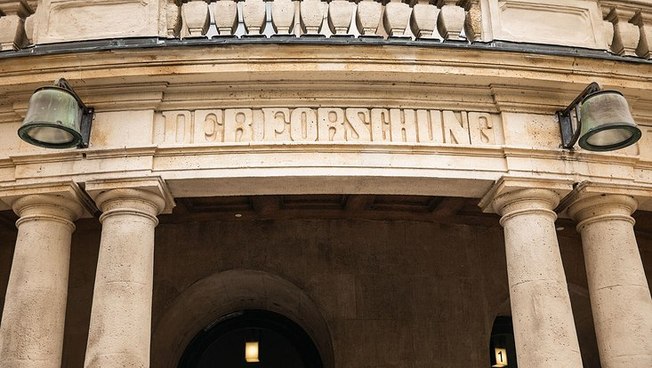26 October 2023
Three New EU Projects with Universität Hamburg Researchers

Photo: UHH/Esfandiari
The funded researchers and their teams will work on innovative research issues while also cooperating with various scientific institutions. The project groups will bundle their different skills, knowledge, and resources in an innovative way to tackle research questions together. Funding can amount to up to €15 million and be granted for a duration of up to 6 years.
University president Prof. Dr. Hauke Heekeren: “Universität Hamburg—University of Excellence stands for outstanding research and the Universität Hamburg researchers involved in the 3 new EU projects are carrying the banner. These extraordinary researchers and their outstanding scientific achievements and projects in top-level research have now been duly recognized with these ERC Synergy Grants—among the most prestigious scientific grants offered by the European Research Council. I congratulate all of the recipients on this success, which underscores Universität Hamburg’s thematic spectrum.”
Prof. Dr. Arwen Pearson and Dr. Irene Fernandez-Cuesta: Time-Resolved Imaging of Membrane Transporter Dynamics under Physiological Ionic Gradients (GRAIL)
The cells of all living systems interact permanently with their environment. But what happens exactly when proteins do their work? The researchers will try to answer this question in their new ERC research project GRAIL. The grant will be used to research gradients, the constantly changing chemical conditions within and outside the lipid membranes surrounding cells. The researchers want to find out how the structure and function of gradients influence the integral membrane proteins embedded in the cell membranes. These proteins are important targets for the development of medication, for example, to treat Parkinson’s or cancer, or to overcome resistance to antibiotics.
“Despite their significance, it has not yet been possible to observe the structural dynamics of the proteins under the direct influence of a gradient. In the GRAIL project, we would like to close this fundamental gap by developing new methods to observe membrane proteins in action and in the presence of a gradient,” explains Prof. Dr. Arwen Pearson, professor of experimental biophysics and head of GRAIL. She is doing research in the Department of Physics and in the Cluster of Excellence: CUI: Advanced Imaging of Matter at Universität Hamburg together with the CUI group leader Dr. Irene Fernandez-Cuesta, who will design and build a nano contraption to observe the membrane proteins in action. In the project, they will work closely with Prof. Dr. Dirk Slotboom and Dr. Wiktor Szymanski from the University of Groningen. GRAIL will receive roughly €11 million for 6 years.
Dr. Orna Almogi, Prof. Dr. Harunaga Isaacson, and Prof. Dr. Dorji Wangchuk: Geology of Texts, Genealogy of Concepts, Intellectual Ecosystems: Mapping the Indic and Tibetic Buddhist Text Corpora (Intellexus)
India and Tibet are homes to the largest Buddhist cultures and boast extensive scholarly literature in Sanskrit or Tibetan. These texts have long been the subject of linguistic and historical methods of analysis. With the new Synergy Grant, cutting-edge computer-based tools will be developed to enable study of the material in completely new ways. Above all, AI and natural language processing will be used. To do so, Dr. Orna Almogi, Prof. Dr. Harunaga Isaacson, and Prof. Dr. Dorji Wangchuk from the Asien-Afrika-Institut in the Faculty of Humanities have joined forces with the informatics team headed by Prof. Dr. Shai Fine from the Reichman University in Israel.
The goal is to document the 3 largest Buddhist text corpora in Sanskrit and Tibetan and to illuminate their interdependence and interplay, also with other non-Buddhist texts, and the processes of their development. There are 3 central concerns: the historical genesis of the texts and text corpora; the history of the key concepts and ideas in the texts; and the networks of individuals involved in their genesis and transmission, which could also be seen as intellectual ecosystems. The grant is roughly €10 million, with about €7 million of it going to Universität Hamburg. The project will run for 72 months.
Prof. Dr. Chris Biemann: The Cultures of the Cryosphere. Infrastructures, Politics and Futures of Artificial Cooling (CultCryo)
Whether logistics, science, or air conditioning in your own home—the possibility of artificial cooling fundamentally shapes the world in which we live. And yet there has been little research to date on these “artificial cryospheres” and their consequences, for example for climate change. The ERC project CultCryo wants to change this. The project researchers will look at how the infrastructure of artificial cooling on the planet is related to cultural customs—for example, in the fields of food, room cooling, biomedicine, and computer science. Among other things, they will focus on historical reconstruction and the ethical discourse on practices and norms related to the cryosphere.
The project, which is being funded in the amount of €9.9 million, is being coordinated by Dr. Alexander Friedrich from the Leibniz-Zentrum für Literatur- und Kulturforschung Berlin (ZfL Berlin). The ZfL Berlin applied for the grant jointly with the TU Darmstadt, which is the leading institution. Universität Hamburg is also a project partner. Prof. Dr. Chris Biemann, professor of language technology at Universität Hamburg, and his team will provide the technical and computer expertise on the history of digital terminology related to the artificial cryosphere with their program Sense Clustering Over Time (SCoT). In addition to the TU Darmstadt and Universität Hamburg, Paderborn University, the University of Duisberg-Essen, the Australian National University Canberra, the Universität Halle (Martin-Luther University), and the Institute for Social-Ecologlical Research in Frankfurt are involved.
